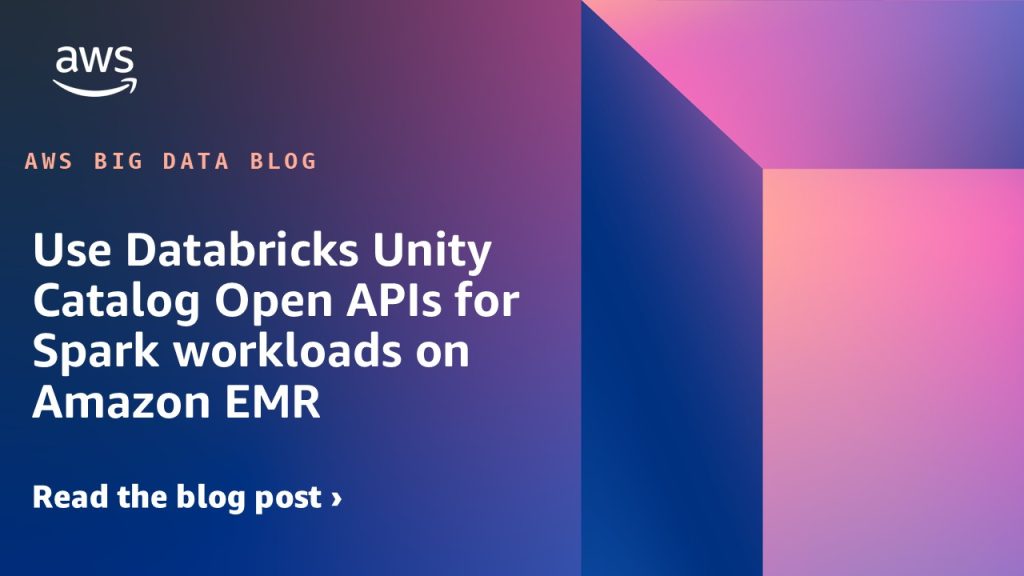AWS Big Data Blog
Tag: Amazon EMR
Use Databricks Unity Catalog Open APIs for Spark workloads on Amazon EMR
In this post, we demonstrate the powerful interoperability between Amazon EMR and Databricks Unity Catalog by walking through how to enable external access to Unity Catalog, configure EMR Spark to connect seamlessly with Unity Catalog, and perform DML and DDL operations on Unity Catalog tables using EMR Serverless.
Centralize Apache Spark observability on Amazon EMR on EKS with external Spark History Server
This post demonstrates how to centralize Apache Spark observability using SHS on EMR on EKS. We showcase how to enhance SHS with performance monitoring tools, with a pattern applicable to many monitoring solutions such as SparkMeasure and DataFlint.
Amazon SageMaker Lakehouse now supports attribute-based access control
Amazon SageMaker Lakehouse now supports attribute-based access control (ABAC) with AWS Lake Formation, using AWS Identity and Access Management (IAM) principals and session tags to simplify data access, grant creation, and maintenance. In this post, we demonstrate how to get started with SageMaker Lakehouse with ABAC.
Read and write Apache Iceberg tables using AWS Lake Formation hybrid access mode
In this post, we demonstrate how to use Lake Formation for read access while continuing to use AWS Identity and Access Management (IAM) policy-based permissions for write workloads that update the schema and upsert (insert and update combined) data records into the Iceberg tables.
Implement Amazon EMR HBase Graceful Scaling
Apache HBase is a massively scalable, distributed big data store in the Apache Hadoop ecosystem. We can use Amazon EMR with HBase on top of Amazon Simple Storage Service (Amazon S3) for random, strictly consistent real-time access for tables with Apache Kylin. This post demonstrates how to gracefully decommission target region servers programmatically.
Architect fault-tolerant applications with instance fleets on Amazon EMR on EC2
In this post, we show how to optimize capacity by analyzing EMR workloads and implementing strategies tailored to your workload patterns. We walk through assessing the historical compute usage of a workload and use a combination of strategies to reduce the likelihood of InsufficientCapacityExceptions (ICE) when Amazon EMR launches specific EC2 instance types. We implement flexible instance fleet strategies to reduce dependency on specific instance types and use Amazon EC2 On-Demand Capacity Reservation (ODCRs) for predictable, steady-state workloads. Following this approach can help prevent job failures due to capacity limits while optimizing your cluster for cost and performance.
Enhance your workload resilience with new Amazon EMR instance fleet features
Amazon EMR has introduced new features for instance fleets that address critical challenges in big data operations. This post explores how these innovations improve cluster resilience, scalability, and efficiency, enabling you to build more robust data processing architectures on AWS.
Use Batch Processing Gateway to automate job management in multi-cluster Amazon EMR on EKS environments
AWS customers often process petabytes of data using Amazon EMR on EKS. In enterprise environments with diverse workloads or varying operational requirements, customers frequently choose a multi-cluster setup due to the following advantages: Better resiliency and no single point of failure – If one cluster fails, other clusters can continue processing critical workloads, maintaining business […]
Migrate data from an on-premises Hadoop environment to Amazon S3 using S3DistCp with AWS Direct Connect
This post demonstrates how to migrate nearly any amount of data from an on-premises Apache Hadoop environment to Amazon Simple Storage Service (Amazon S3) by using S3DistCp on Amazon EMR with AWS Direct Connect. To transfer resources from a target EMR cluster, the traditional Hadoop DistCp must be run on the source cluster to move […]
How the GoDaddy data platform achieved over 60% cost reduction and 50% performance boost by adopting Amazon EMR Serverless
This is a guest post co-written with Brandon Abear, Dinesh Sharma, John Bush, and Ozcan IIikhan from GoDaddy. GoDaddy empowers everyday entrepreneurs by providing all the help and tools to succeed online. With more than 20 million customers worldwide, GoDaddy is the place people come to name their ideas, build a professional website, attract customers, […]









